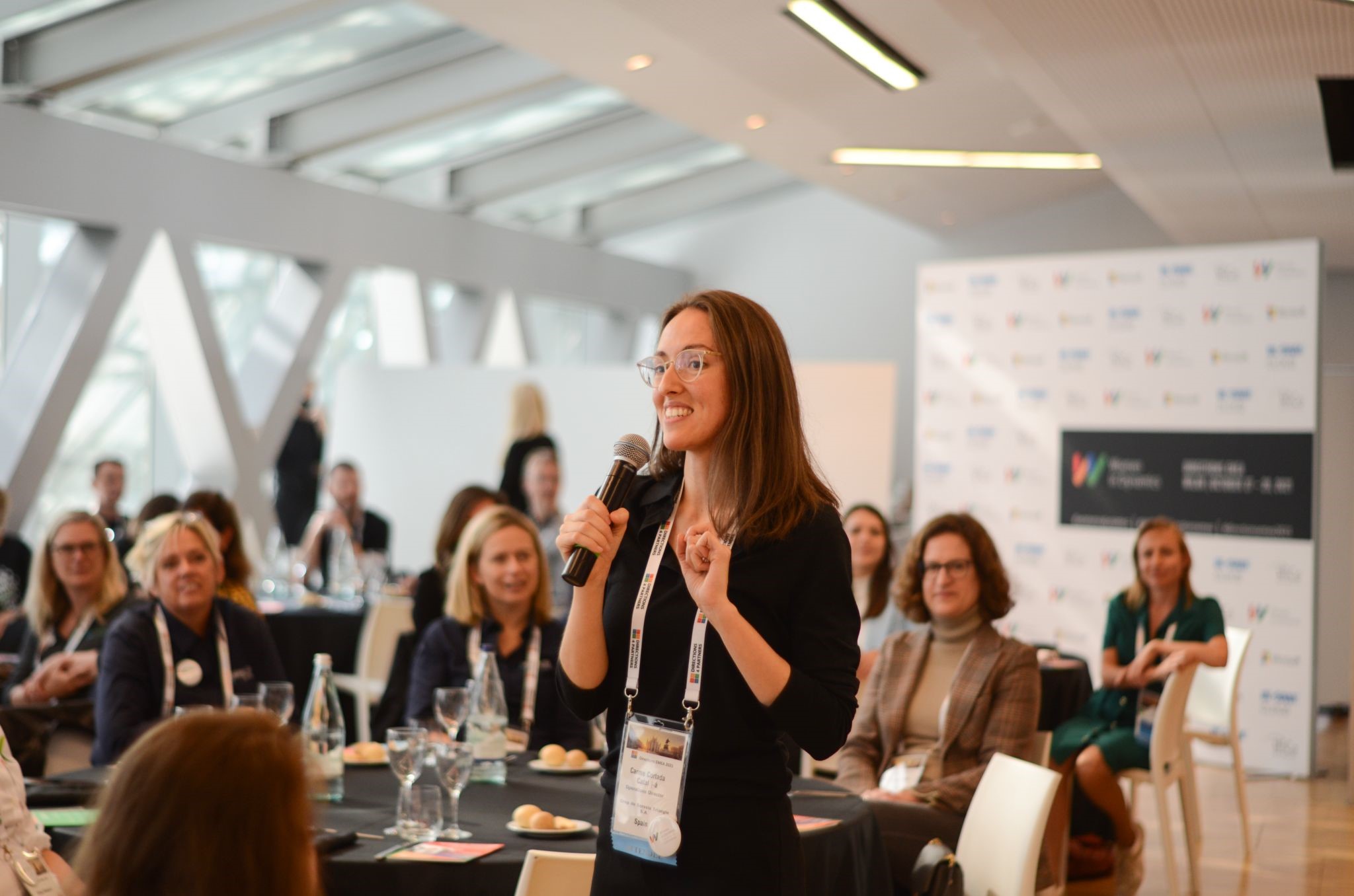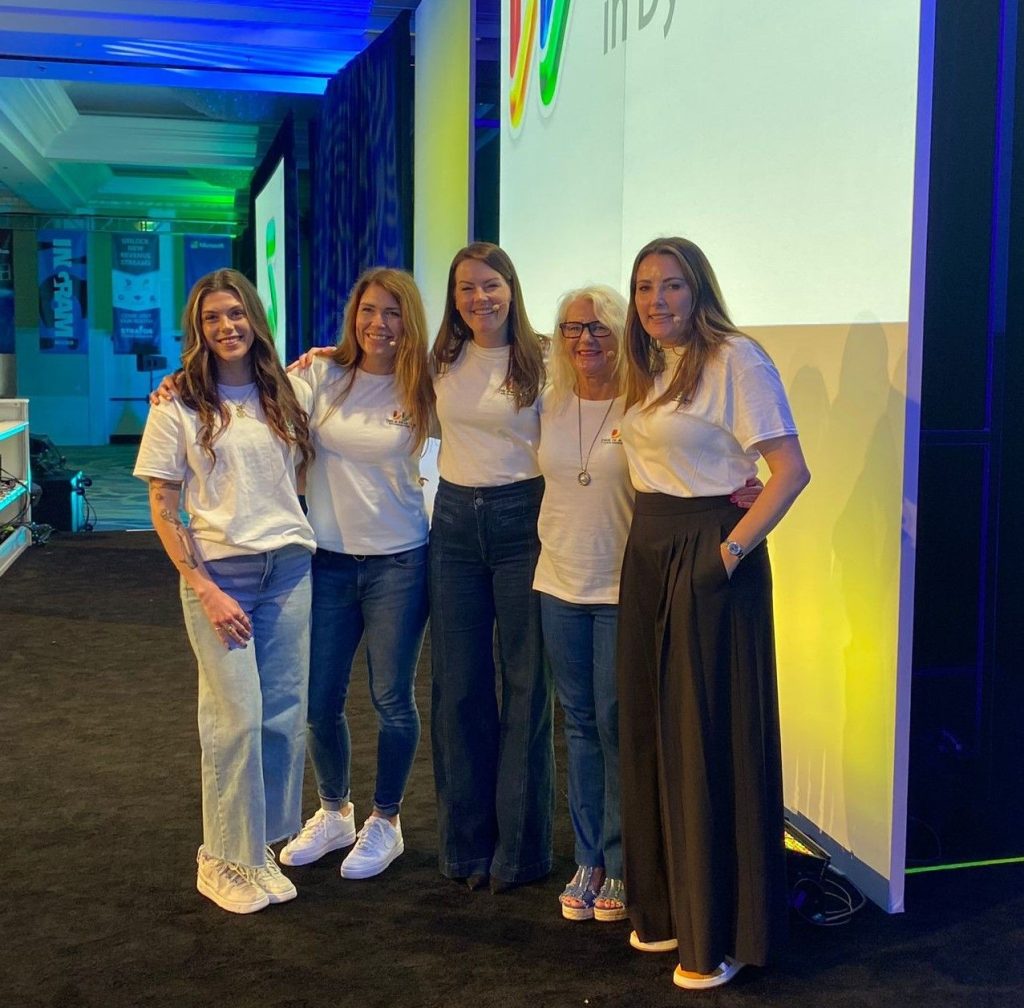We caught up with Carme Cortada, CEO of the long-standing Microsoft partner Triangle and Women in Dynamics (WID) Board Member, to get her tips on what it’s like to join the Dynamics 365 channel.
Joining the Dynamics 365 channel as a young woman
With a background in SaaS, Carme joined the Dynamics 365 channel back in 2017. She became the Director of Operations at the long-standing Microsoft partner Triangle, aged just 25. At the time, the industry was undergoing a huge shift from on-premise to cloud solutions, promising an exciting future ahead.
“Before I joined the channel, I had the preconception that this technology was outdated, so seeing that change was great! Once I got to know Microsoft’s vision and where they wanted to take Dynamics 365, I could really see a career for myself in the channel.”
However, despite the rapid technological shifts, Carme felt that the working culture in the channel was lagging behind.
“There was plenty of technological innovation, but little innovation from a company culture perspective, and no discussions around it, so I really wanted to be part of that change. Interestingly, the technological advancements meant that companies simply had to change the profile of who they were hiring, opening up discussions around culture as a Dynamics 365 community. Today, pretty much everyone in the community agrees that we need to attract a more diverse talent pool to create products and deliver experiences that serve a diverse population of customers.”
As a Board Member of WID, Carme is passionate about understanding the representation of women within the partner channel and how that compares to the wider tech sector. She’s eager to share tips and advice for companies looking to address the gender imbalance within the workplace.

How has the consultant’s profile changed over the last few years?
With more and more low-code solutions being developed for products in the Dynamics 365 suite such as Business Central, paired with rapid advancements in AI, the talent profile has changed significantly over the last few years. Carme believes that today, relevant prior industry experience, a diverse perspective, and crucial soft skills, such as effective communication and stakeholder management, are more important than technical abilities or years of experience with Dynamics 365.
“The way technology and tools have changed in the last few years is making the Dynamics 365 channel more attractive to people who may not have otherwise had the opportunity to join this space. It felt like a really closed world before, with hiring focused on talent who possessed skills in very specific coding languages. People who want to work in Dynamics 365 no longer need to commit their entire careers solely to mastering those skills.”
“Today, there’s much more contact with the customer—the clients expect more too, at a faster pace, so the ‘traditional consultant’ profile may no longer fit this environment. Dynamics 365 is now really for people who are eager to learn and update their skills on an ongoing basis, dictated by the shifting requirements of their role and work environment. It’s no longer as crucial to have decades of experience in Dynamics 365. As long as you’re passionate about advancing your skills and making the effort to learn, you’ll do well.”
What challenges do women still face in the Dynamics 365 channel?
“There are still many, many challenges…” says Carme. “And these affect not only women, but anyone who comes from a background that’s underrepresented in tech.”
To uncover some of these challenges, Nigel Frank recently surveyed over 1,110 Microsoft professionals to hear their views on various aspects of hiring and career progression in the Microsoft ecosystem.
The survey found that only 57% of professionals working within the Microsoft ecosystem agree that there is a clear Equity, Diversity, and Inclusion (EDI) policy in their workplace while roughly one-third (32%) either say there isn’t or aren’t sure.
“While there are many challenges I may not be aware of because of my own privilege,” Carme adds, “I would say that one crucial aspect is the salary.”
Data from Nigel Frank suggests that only 38% women working in the Microsoft ecosystem believe that their employer pays men and women equally, compared to 62% of men, illustrating a gender difference in salary and perceptions.
“I think that knowing you’re not going to get a fair salary really impacts your desire to join the channel and how you view yourself or what opportunities you think you deserve,” Carme comments.
What’s more, according to a study by Accenture, half of women working in tech will leave by the time they turn 35, which could be linked to the industry’s lack of support for childcare and negative perceptions around taking and recovering from maternity leave.
“This is a really scary prospect for women. So, any company looking to attract more women also needs to be addressing how they retain women to stay in their roles long-term and progress their careers,” adds Carme.
5 tips for Microsoft partners looking to boost gender balance
It’s clear that despite all the positive strides, there are still issues preventing women from building sustainable careers in the Dynamics 365 space. While this is a huge topic, we hope these tips from Carme will provide a springboard to help you further improve gender balance in your own organization and the wider Dynamics 365 channel.
1. Understand your own part
The first exercise in addressing gender imbalance is understanding. “By this, I mean understanding your own gender representation and company culture,” Carme explains. Once you know that, it will become clearer what areas you should focus on.”
2. Ensure that senior women are always on your interview panel
Seeing women of a higher level of seniority than the role you’re hiring for will really help your candidates get inspired to see their potential career progression path within your company. “For example, if you’re trying to hire more women for, say, a Junior Consultant role, make sure you include women who are Senior Consultants in the interview process,” Carme advises. This will also put your candidates more at ease and inspire them from the get-go.
3. Showcase women role models
“We are fortunate to have 80% women in our leadership team at Triangle, but I appreciate this is not the reality for everyone,” Carme says. No matter where you are on your EDI journey, make sure you elevate the voices of women within your company and showcase women role models. “Due to the biases within our industry, many women feel apprehensive about switching roles. So, you need to be able to convince them that they’ll be supported in your company, that your culture is inclusive, and that they will have opportunities for growth, mentorship, and more,” Carme advises. This will inspire other women to take a leap of faith with your company and switch jobs, rather than playing it safe.
4. Don't try to solve everything
EDI is a huge topic, and it can quickly become overwhelming. But everyone has a unique perspective they can bring to tackle these challenges, and there are areas you may feel more passionate about than others. For instance, some people prefer working with education providers to tackle gender imbalances in STEM at a university or school level. Others, meanwhile, may be more interested in helping women transition from junior to leadership roles. Others still may resonate with improving the onboarding process to support women. “It’s important to find what you’re more passionate about naturally, or what resonates with you,” Carme says, “because that’s where you’ll have the most impact.”
5. Advocate male allyship
In general, gender equity initiatives tend to be three times more successful if men across the organization are involved. This is not surprising, considering that men still occupy most senior leadership roles, especially in tech. “When it comes to EDI, male allyship is crucial,” Carme says. “Whatever you choose to do in your company, make sure there’s a diverse group of people supporting this from the beginning, including men. Otherwise, you may get disheartened from putting in efforts that don’t appear to yield significant results.”
If you’re looking for Business Central specialists with prior industry experience while also looking to solve the gender imbalance in the Dynamics 365 channel, then ReSKILL is for you. Find out how three women—Sofia, Jana, and Carcyn—reimagined their careers with Business Central through ReSKILL, a program co-designed by Microsoft and its collaborators as part of the Business Central Talent Initiative, in this article.
Hear more from Jana and her new employer, Socitas, in this video.
Bonus tips from WID Directions North America 2024
Here are more tips and insights from speakers at the WID sessions at Directions North America 2024, to help you progress EDI efforts within your own company and the wider partner channel.

“Hire more women by creating a blind recruitment process where names are fully anonymized. Don’t wait for a candidate to ask you about flexibility; bring it up proactively at all stages.”
Line Caspersen, SVP Sales, USA, #BCTalent team
“Meeting every employee and customer with trust and respect—they don’t have to earn it; they have it!”
Karina Nielsen, CEO at Ciellos
“We have to give space for conversations and challenge the culture of tech. Everything isn’t an emergency, and everything doesn’t need to be done after 5pm. And when it does, we need to give the choice to everyone.”
Kristen Sage, MBA, CEO at Western Computer
“Be the example, be the change, and be the chance. Encourage your direct reports to not only achieve their objectives but also to report on how they helped others achieve theirs and how they’ve been impacted by the help of other team members.”
Cecilia Flombaum, Senior Director of Scale Growth at Microsoft and WID Board Member
